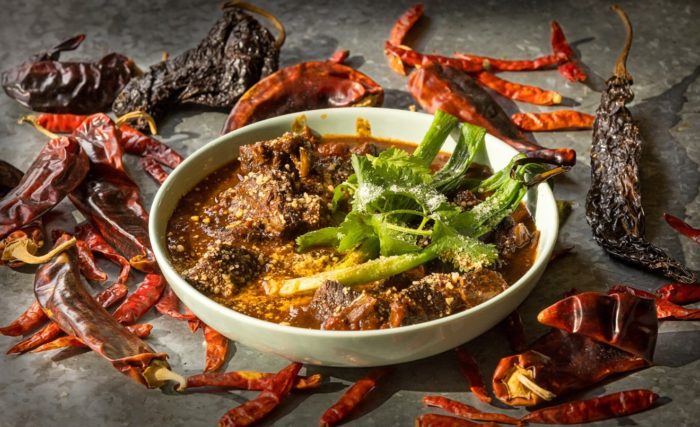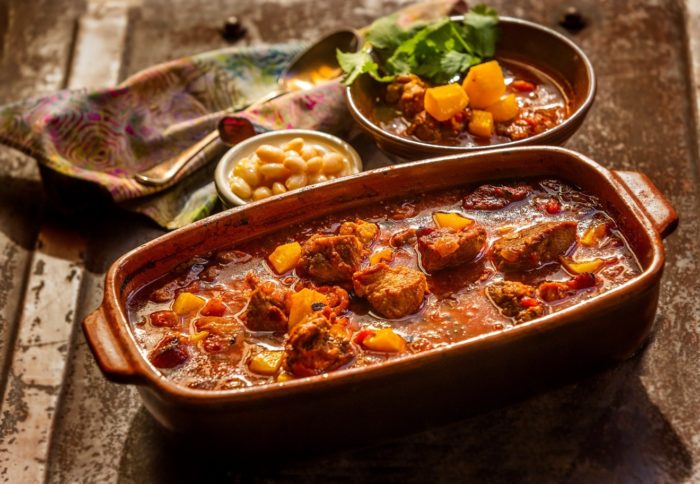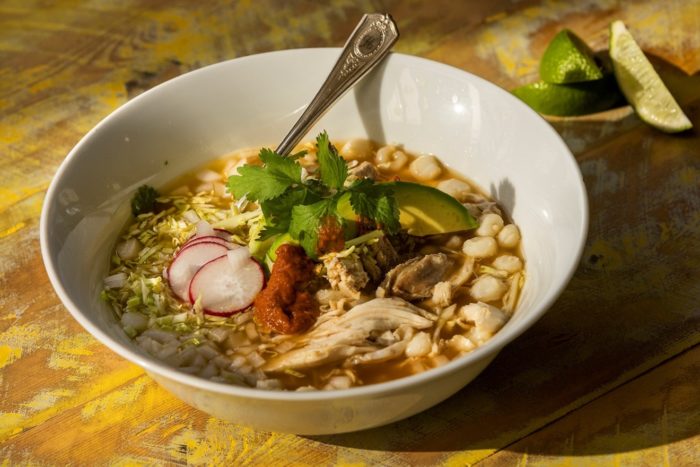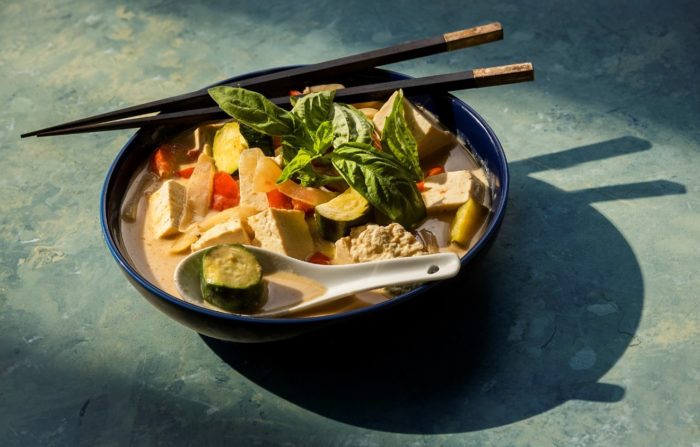OK . . . here’s your culinary quiz for today: What is a stew? If you look in culinary dictionaries, stews are defined as using a cooking technique called braising. In fact, the words stewing and braising mean the same thing. Braising is a moist-heat cooking technique that breaks down tough cuts of meat and turns them tender and succulent. It’s done at low heat over a relatively long period of time in a pot with a lid on, either on the stovetop or in the oven.
Meats like beef chuck, short ribs, brisket, oxtail, pork shoulder, and lamb shanks are great for braising, as are dark-meat cuts of chicken like thighs and drumsticks. Depending on the meat, cooking time can vary widely from a few minutes for seafood to several hours for a tough piece of red meat. The Oxford Companion to Food notes that stews have many practical advantages: “Everything can be combined in one pot so there is no wastage of fuel and less washing up. The mixture of ingredients in a thick and opaque sauce casts a veil of uncertainty over the proportions of expensive ingredients to cheap ones (I love that observation). It also enables the cook to be away from the kitchen before a meal.”
Traditionally, the meat is first browned in hot fat before covering it either partially or completely with stock or some other flavorful liquid along with flavorings and seasonings and simmered at a low temperature, ideally just below boiling at between 205 and 210° F.
This is the temperature at which the connective tissues in meat breaks down and turns into collagen, which thickens and adds body to the cooking liquid. Sometimes the meat is coated in flour before browning it, which adds additional thickening.
If you’re making stew as opposed to pot roast, you typically cut the meat into smaller pieces, but the cooking method is the same. Vegetables like carrots and potatoes typically go in towards the end of the cook time so that they don’t get mushy. Your choice.
Though traditionally we associate “stew” with red meat, cooked in a single pot the term has now morphed to include any protein. OK, onto some of my favorite recipes. Not all are meat based.

TEXAS RED
Makes about 12 cups; serves 6 – 8
No beans but you could add them if you like. I usually serve this with jasmine rice and a garnish of grated cotija cheese and cilantro and some pan grilled green onions.
8 whole mixed dried chiles (5 ancho and 3 guajillo or all ancho), about 3 ounces
3 tablespoons vegetable oil, plus more as needed
3 pounds trimmed beef chuck, cut into small pieces (1 inch or so)
Salt and freshly ground pepper
2 large onions, coarsely chopped (4 – 5 cups)
8 garlic cloves, minced (5 tablespoons)
2 jalapeno or serrano chiles, seeded if desired, minced
2 1/2 teaspoons ground cumin
1 1/2 teaspoons dried oregano
1 can (28 ounces) whole peeled plum tomatoes, hand crushed or pureed with their juice
4 cups beef or chicken stock
1 tablespoon dark brown sugar
2 tablespoons soy sauce
2 to 3 teaspoons red wine vinegar, or to taste
Toast dried chiles in a dry skillet over medium-high heat until fragrant and puffed, 1 to 2 minutes per side. Remove stem and seeds and discard. Transfer chiles to a large measuring cup or bowl, and cover with hot water. Keep chiles submerged with a small plate on top and let soak for 30 minutes. Remove from water and puree in a blender with 1/2 cup or so soaking liquid. Reserve remaining soaking water for thinning.
Heat a large heavy pot over high heat. Add 2 tablespoons oil. Season beef with 2-1/2 teaspoons salt and 1/2 teaspoon pepper. Brown beef in two batches, adding more oil as needed, about 10 minutes. Transfer to a bowl.
Add remaining tablespoon oil, the onions, garlic and minced serranos to pot, and cook over medium-high heat until onions are translucent, about 5 minutes. (If the pan gets too dark, add a little water, and scrape up browned bits with a wooden spoon to deglaze.) Add cumin and oregano, and cook, stirring, until fragrant,1 minute.
Stir in browned beef and chile puree. Add tomato, stock, sugar, and 1 teaspoon salt. Bring to a boil. Reduce heat and simmer gently, covered until meat is very tender, and juices are thick, 2 1/2 to 3 hours. (Check pot once an hour for excessive evaporation; if chili mixture seems dry, add a little of the chile soaking water.) Season stew with salt to your taste and stir in soy sauce and vinegar. Serve immediately (or refrigerate for up to 3 days or freeze for up to 3 months; reheat in a pot over medium heat, stirring occasionally).
BRAISED SHORT RIBS WITH SOFT POLENTA
Serves 4 – 6
Anything can be added to flavor the rich braising liquid such as dried porcini (rehydrated and sautéed along with the onions), a little ancho or chipotle chile, etc. The dish is even better when made ahead and reheated and it freezes beautifully.
3 pounds boneless short ribs, trimmed of fat
Salt and freshly ground pepper
4 tablespoons olive oil
6 large cloves garlic, clove separated and peeled
2 cups diced white onions
1 cup diced carrot
1 cup diced celery
2 cups chopped mushrooms
2 cups canned diced tomatoes
1 bottle (or more) hearty dry red wine
3 cups rich beef, chicken or vegetable stock
1 tablespoon each chopped fresh rosemary and thyme (2 teaspoons dried)
2 teaspoons fennel seed
1 tablespoon cornstarch softened in 1/3 cup wine or water (optional)
Soft polenta (recipe follows)
Preheat oven to 325 degrees. Season short ribs generously with salt and pepper. Heat 3 tablespoons oil in a deep heavy bottomed pot or Dutch oven large enough to hold the short ribs in one layer. Over medium-high heat, brown the ribs on all sides. Remove short ribs, reserve and discard all but 2 tablespoons of the fat from the pot.
Add garlic, onions, carrot, celery and mushrooms to the pot and cook over medium heat, stirring occasionally, until softened and lightly browned. Add the tomatoes, wine and stock and bring to boil. Add the short ribs, herbs and fennel seed. Cover with a lid or foil and braise in the oven for 2 1/2 hours or until very tender.
Transfer the ribs to a platter. Strain cooking juices through fine strainer, discard the solids. Remove and discard as much fat as you can. Return strained juices to the pot and over high heat, reduce until lightly thickened and concentrated, about 10 – 15 minutes. You can thicken if desired by whisking in as much of the cornstarch mixture as you desire. Correct seasoning and add short ribs back to pot and reheat.
To serve: Spoon soft polenta onto shallow bowls. Top with short ribs and sauce.
Soft polenta
Serves 4 – 6
4 cups chicken stock or water
1 cup yellow polenta corn meal
2 tablespoons butter
1/3 cup freshly grated parmesan cheese
Salt and freshly ground black pepper
Bring the stock to a boil in a deep saucepan. Gradually whisk in the polenta and then reduce heat to medium. Cook stirring regularly until the polenta is thick and pulling away from the sides of the pan, about 15 minutes. Cover and keep warm until ready to serve. If it gets too thick, stir in a bit more stock or water. Just before serving stir in butter and cheese and season to your taste with salt and pepper.
PEPOSO: SLOW COOKED ITALIAN BEEF STEW
Serves 4 – 6
This is a variation of an ancient Italian recipe called “Peposo” which is so named because it uses a lot of black pepper. It’s a simple recipe and something happens in the long slow cooking that gives the meat great flavor and texture and mellows the pepper. Start this in the morning and your hose will smell delicious all day long! If you still have a crock-pot or other slow cooker – – now is the time to drag it out! Traditionally this was served over day old crusty bread topped with the braising liquid. You could also serve it with potatoes (mashed or roasted), polenta or pasta. Here I’ve cut the beef up, but you could also leave it in a whole piece. Recipe calls for cracked pepper, which is best done at the last moment. Use a coffee grinder, mortar and pestle if you have one or the bottom of a heavy cast iron pan rolled around on whole peppercorns also works great.
2-1/2-pound lean stewing beef, cut in 2-inch square portions
3 tablespoons olive oil
16 whole cloves of garlic, peeled and left whole
2 tablespoons or so cracked black pepper (not ground)
4 cups canned diced tomatoes in juice
2 cups hearty red wine such as Cabernet or Zinfandel
1 cup chopped basil leaves
Salt to taste
Garnish: Gremolata (recipe follows)
Brown the beef quickly in the oil in a large heavy Dutch oven or pot, preferably ceramic or enamel. Pour off fat and place all remaining ingredients except salt into the pot. Cover tightly and place in a preheated 275-degree oven for 8 – 10 hours. Alternately you could do this on the stovetop over very low heat. The idea is to bring the mixture to a very gentle simmer. Check occasionally and if the liquid begins to boil away add a little boiling stock, wine or water and turn heat down lower. Cook until meat is very tender. Remove meat to a deep platter and keep warm. Degrease cooking liquid if needed and add salt to taste. Return meat to braising liquid and serve topped with a sprinkling of gremolata.
Gremolata
Makes about 1/2 cup
This is a fast one to do with a mini food processor or you can do it by hand.
3 large cloves garlic
1 cup packed parsley leaves
2 – 3 tablespoons finely grated lemon zest
1/2 teaspoon or so salt
Pulse the garlic, parsley and lemon to finely chop it. Be careful not to turn it into a paste. It should be light and airy. Add salt to taste.

PORK STEW WITH WHITE BEANS AND BUTTERNUT SQUASH
Serves 8 – 10
A rustic stew that could also be done in the slow cooker.
1 medium butternut squash, peeled seeded and cut into 1-1/2-inch cubes
3 tablespoons or so olive oil
Sea Salt and freshly ground black pepper
3 pounds boneless pork shoulder cut into 1-1/2-inch cubes
1 large onion, diced
2 tablespoons finely sliced garlic
1 heaping teaspoon Dijon mustard
1 tablespoon tomato paste
1-1/2 teaspoons smoked hot paprika or to taste
3 cups canned diced tomatoes in juice
3 cups chicken or mushroom stock
1 teaspoon dried thyme
4 cups or so cooked white beans such as Great Northern
Preheat the oven to 425° F with convection if available. Toss the squash with 2 tablespoons olive oil and season well with salt and pepper. Scatter the squash in a single layer on a rimmed baking sheet and roast, turning once or twice until the squash is lightly browned and tender but not mushy, about 25 minutes. Set aside. Reduce oven temperature to 350° F.
Add the remaining tablespoon of olive oil to a Dutch oven and set over medium-high heat. When the oil is hot, season the pork well with salt and add half of it to the pot. Brown the cubes on all sides, about 6 minutes total. Remove the pork to a plate with a slotted spoon and repeat with the rest of the meat, adding more oil if necessary.
When the pork is browned, turn the heat to low and add the onion and a pinch of salt. Cook, stirring frequently, until softened, about 5 minutes. Add the garlic and cook for another couple of minutes until fragrant. Stir in the mustard, tomato paste and smoked paprika and cook for another 2 minutes
Add the tomatoes, stock, thyme and 2 teaspoons salt, as well as the browned pork and any accumulated juices. Stir and bring the stew to a boil over medium-high heat. Reduce heat to a simmer, cover the pot and transfer it to the oven. Cook for an hour and a half or until the meat is very tender. Skim the surface of any excess fat
Add the beans (or place on the side) and simmer for 5 minutes. Serve in deep bowls topped with the butternut squash.
SPICED LAMB STEW
Serves 6
A simple stew with flavors reminiscent of Morocco or Moorish Spain. Serve with saffron or cilantro rice if desired.
2 medium eggplants
1 tablespoon Kosher or sea salt, plus more for seasoning
1/2 cup golden raisins
4 tablespoons red wine vinegar
6 tablespoons olive oil
3 pounds lamb stew meat cut into 1-1/2 inch cubes
2 medium white onions, peeled and chopped
4 large cloves garlic, peeled and slivered
1 large poblano chile, seeded and stemmed and cut into large dice
2 cups chopped, seeded ripe tomatoes or canned diced tomatoes in juice
3 tablespoons honey
2 teaspoons cinnamon
1/2 cup chopped parsley
Freshly ground black pepper
1/4 cup chopped fresh mint
Preheat oven to 375° Fahrenheit.
Cut the eggplant into 1-inch cubes, sprinkle with 1 tablespoon kosher salt, and set aside in a colander to drain.
Mix raisins with vinegar in a small bowl and set aside.
In a large heavy oven proof Dutch oven or similar pot, heat 3 tablespoons of olive oil and brown lamb, in two batches if necessary. Remove lamb with a slotted spoon and set aside in a large bowl.
Pour off all but 2 tablespoons of fat, reduce the heat to medium and sauté onions, garlic and chile until softened and very lightly browned, about five minutes. Remove and add to the lamb.
Rinse eggplant and dry thoroughly. Heat remaining 3 tablespoons olive oil and sauté eggplant over high heat until lightly browned and softened, about 4 minutes.
Add reserved lamb, onion mixture, raisin mixture, tomatoes, honey, cinnamon, parsley and season liberally with salt and pepper. Mix well. Cover and bake 45-50 minutes or until meat is tender. Stir in mint just before serving.
BRISKET BRAISED IN COFFEE
The great virtue of brisket of beef is the fact that it is marbled with fat between the connective tissue or collagen. This tissue, when cooked slowly in a low oven or smoker or braised in a flavorful liquid, melts and the fiber of the meat softens to yield one of the most succulent pieces of meat that I can imagine. Brisket has become a very “in” cut and certainly one of the most versatile whether part of a K.C. or Texas barbecue, sliced for a Southeast Asian Pho, simmered for an Italian Bollito Misto, corned for St. Patrick’s Day or pot roasted for Rosh Hashana. This is one of my favorite recipes for this humble cut of meat. Like most stew or braises, it’s even better the next day reheated!
Serves 6 – 8
4 tablespoons olive oil
4 pounds brisket of beef, trimmed of excess fat if necessary
Salt and freshly ground black pepper
3 large onions (1 ½ – 2 pounds), sliced
1/4 cup sliced fresh garlic
2 tablespoons (or more) ancho or chipotle chile powder
2 teaspoons each whole fennel and cumin seed
2/3 cup brown sugar
2/3 cup apple cider vinegar
4 cups strong brewed coffee
1 cup rich meat or mushroom stock
1 – 14 ½ ounce can diced tomatoes in juice
Add 2 tablespoons of the olive oil to a deep pot or Dutch oven and quickly brown the brisket on both sides, seasoning liberally with salt and pepper. Remove the meat from the pot, discard the fat and wipe the pot out.
Back on stove add the remaining oil and sauté the onion and garlic until just beginning to color. Add the chile and sauté for a minute more or until fragrant. Add the spices, sugar, vinegar, coffee, stock and tomatoes and bring to a simmer. Return meat to the pot, cover and place in a preheated 300-degree oven for 3 – 3 ½ hours or until meat is very tender,
Remove meat and set aside. Puree the braising liquids and vegetables until smooth and season to taste with salt and pepper. Return meat to the pan and add enough of the pureed sauce to not quite cover the meat. Return pot to oven and bake uncovered for 30 – 45 minutes more or until brisket is nicely glazed. Serve cut thinly across the grain or “pulled” (shredded) with the warm pureed sauce spooned over.

POSOLE BLANCO WITH CHICKEN
Serves 8 – 10 generously
A classic Mexican recipe that falls into the soup/stew world and can be made with pork, chicken, goat, etc. The salsa Colorado is usually stirred into the stew before serving but do ahead if you like.
2 small white onions, peeled and halved
6 large peeled garlic cloves
2 large bay leaves
2 teaspoons whole cumin
6 cloves
Salt and freshly ground pepper
3 to 4 pound roaster chicken, trimmed of excess fat
2 29-ounce cans white posole (hominy) drained and thoroughly rinsed
Salsa Colorado (recipe follows)
Garnishes (use any or all):
4 cups finely shredded green cabbage,
1 bunch finely sliced radishes,
2 cups finely diced white onion
1 large avocado, peeled, seeded and diced
Dried Mexican oregano*
Cilantro sprigs
Lime wedges
Add onions, garlic, bay leaves, cumin, cloves, 2 teaspoons salt, 1 teaspoon pepper and 3 quarts water to a large deep pot and bring to a boil. Add the chicken and bring back to the simmer. Cover and slow simmer until meat is very tender, about 1-1/2 hours. Remove chicken and when cool enough to handle discard skin and bones and coarsely chop or tear the chicken into bite size pieces.
Strain stock. If making ahead refrigerate and you can easily remove and discard the fat cap. Remove as much fat from the stock as you can, add the hominy and chicken and bring to a simmer. Adjust salt and pepper to taste and serve with the salsa and other garnishes on the side, each guest adding what they like.
Salsa Colorado
Makes a cup or so
8 Guajillo chilies, seeds and stems removed
6 Chiles de Arbol, stems removed
3 large garlic cloves
1 cup chopped white onions
2 tablespoons olive oil
1 teaspoon ground cumin
1 teaspoon dried, preferably Mexican* oregano
2 tablespoons apple cider vinegar
2 teaspoons or so organic sugar
Salt to taste
In a small skillet, toast the guajillos, chilies de árbol and garlic over moderately high heat until toasted in spots and fragrant. Set aside. Be careful not to burn them or they will become bitter. Bring 4 cups of water to a boil. Add the chilies and, off heat, let them soak for 15 – 20 minutes with a small plate on top to keep them submerged.
Peel the garlic. Add olive oil to a small sauté pan along with the onions and cook over medium heat until lightly toasted. Remove chilies from the water and put in a blender along with the garlic, cumin, oregano, vinegar, sugar and salt to taste and add enough of the soaking water to make a smooth salsa. Can be made ahead and stored refrigerated for 7 days.
*Mexican oregano is a bit different from Mediterranean oreganos. It has a more floral flavor and is in fact related to lemon verbena. You can certainly use Mediterranean oregano in its place.
COUNTRY CAPTAIN CHICKEN CASSEROLE
Serves 4
If you grew up in the South, then this is probably a dish familiar to you. It’s a Low Country classic and its origin is somewhat controversial. The English have a similar dish with a similar name and believe that its origins were from a British officer who brought the recipe back from his station in India. Others maintain that the dish originated in Savannah, Georgia, which was a major shipping port in America for the spice trade. There are probably as many variations on this recipe as there are cooks who prepare it!
1 cup flour
1 teaspoon dried thyme
Kosher or sea salt and freshly ground black pepper
4 plump chicken whole leg-thighs
3 tablespoons vegetable oil
6 slices bacon, chopped
2 tablespoons finely chopped garlic
2 cups cored, seeded, and chopped poblano or green bell peppers
3 cups chopped onion
2 tablespoons or so Madras style curry powder, or to taste
1 28-ounce can crushed tomatoes with basil
1 cup or so chicken stock or dry white wine
1⁄2 cup golden raisins or currants
2 bay leaves
4 cups steamed fragrant white rice such as Basmati
1/4 cup chopped, dry roasted peanuts
1/4 cup toasted dried and shredded coconut, optional
Combine the flour, thyme, 2 teaspoons salt and 1 teaspoon pepper. Dredge the chicken in the seasoned flour and shake off excess. Heat a large Dutch oven or deep skillet with the oil over moderately high heat. Add chicken, skin side down, and cook, turning once, until golden brown, about 10 minutes. Transfer chicken to a plate and set aside.
Discard all but 1 tablespoon of oil from the pan and oil add bacon and cook, stirring occasionally, until crisp, about 6 minutes. Using a slotted spoon, transfer bacon to a paper towel–lined plate and set aside. Add the garlic, peppers, and onions to the Dutch oven and cook, stirring occasionally, until soft and just beginning to brown, about 10 minutes. Add the curry and cook stirring for another minute or 2 or until curry is fragrant. Add tomatoes, stock, raisins, and bay leaves and season to your taste with salt and pepper.
Add the reserved chicken to the Dutch oven, nestling it into the sauce; spoon some of the sauce over chicken. Cover and cook the chicken at a simmer until it’s very tender, about 1 hour and 15 minutes. Serve on rice topped with the reserved bacon, peanuts and coconut.

THAI CURRY WITH TOFU AND ZUCCHINI
Serves 4 to 6
Everyone needs at least one tasty tofu dish to convince the non-believers that tofu can be really good. Just look at it as a blank canvas ready to take on just about any global flavor you throw at it! This is a quick dish, and you could substitute whatever vegetables you like, maybe bean sprouts, eggplant or wedged cabbage?
1 tablespoon vegetable oil
1 large white onion cut into large dice
2 small red bell peppers, stemmed, seeded, deribbed and cut into large dice
2 tablespoons Thai red curry paste or to taste
2 cups hot vegetable stock or water
2 tablespoons Asian fish sauce
1 tablespoon brown sugar
2 tablespoons fresh lime juice
1 (14 1/2-ounce) can unsweetened coconut milk, stirred
2 medium zucchini, trimmed, quartered lengthwise then cut into chunks
One 12 to 14-ounce package firm tofu, drained and cubed
Handful basil leaves, torn preferably Thai basil
Fresh lime wedges
Heat the oil in a wok or skillet. Add the onion and stir-fry until slightly softened, about 2 minutes. Add the peppers and stir-fry for 1 minute.
Dissolve the curry paste in the hot stock, then add to the wok along with the fish sauce, sugar and coconut milk. Bring to a simmer, then add the zucchini and tofu. Cover and simmer for 6 to 8 minutes, until the zucchini have softened.
Just before serving, add the basil. Serve with lime wedges to squeeze in as desired
Note: Thai red curry paste and fish sauce are available in Asian markets and the ethnic foods section of many supermarkets.
John Ash © 2022



